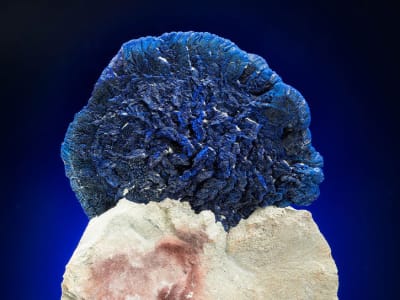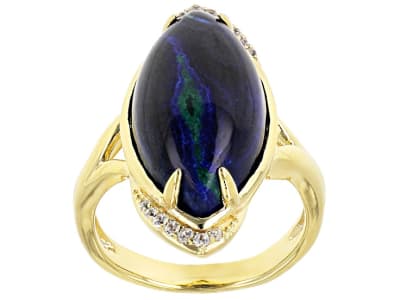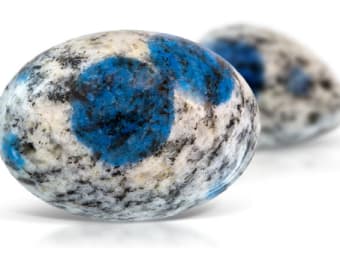Azurite is a copper carbonate mineral found in the oxidation zones of copper deposits and is considered a secondary ore of copper. Color ranges from light to dark blue, with medium to dark blue being more common. The intensity of its hues is what makes azurite a popular collector's stone. Azurite is commonly found in conjunction with malachite, a green copper carbonate mineral into which it slowly morphs. A mix of the two minerals is known as azurmalachite. Azurite is soft (3.5 on the Mohs scale) and opaque. When used in jewelry, it is usually seen in the form of cabochons or beads.
General Information
Tolerance:(+0.010/-0.010)
LWUV: Inert
Azurite Colors
-
 Blue
Blue
Alternate Names
Chessy Copper, Chessylite, Azure Stone
Countries of Origin
Papua New Guinea; Angola; Cambodia; Sudan; Kazakhstan; Paraguay; Portugal; Greece; Mongolia; Morocco; Unknown; Mali; Iraq; Chile; Argentina; Zambia; India; Canada; Turkey; Belgium; Namibia; Finland; South Africa; Jamaica; Peru; Venezuela (Bolivarian Republic of); Germany; Viet Nam; Hong Kong; Madagascar; United Kingdom of Great Britain and Northern Ireland; Sweden; Poland; Bulgaria; Nigeria; Tunisia; Croatia; Syrian Arab Republic; Switzerland; Spain; Azerbaijan; Cuba; Mauritania; Guernsey; Swaziland; Congo (the Democratic Republic of the); Israel; Australia; Myanmar; Malaysia; Oman; Bosnia And Herzegovina; Armenia; Austria; Korea (the Republic of); Luxembourg; Brazil; Algeria; Slovenia; Colombia; Ecuador; Iran (Islamic Republic of); Hungary; Japan; Belarus; Taiwan (Province of China); Albania; Bolivia (Plurinational State of); Lao People's Democratic Republic; New Zealand; Italy; Antarctica; Macedonia (the former Yugoslav Republic of); Afghanistan; Russian Federation; Czechia; United States of America; Egypt; Saudi Arabia; Pakistan; China; Ireland; Slovakia; France; Serbia; Kyrgyzstan; Romania; Philippines; Uzbekistan; Norway; Botswana; Dominican Republic; Mexico; Uganda; Zimbabwe; Greenland; Indonesia
History
The name azurite comes from its color of azure. The opaque blue of azurite is so perfectly blue it was used centuries ago by painters for blue pigment. Azurite is often found growing with malachite. Each is lovely in its own right, but together they are exceptional. Azurite is a 3 ½ - 4 on the Mohs scale. It's a desirable stone for collectors and is often used decoratively as it is naturally artful. When it's found in granite matrix (the rock in which it forms), it's a compelling blend of blue and white, often with whispers of black and gray.
Care
Azurite is very soft, so be mindful of scratching. Avoid abrasives, ultrasonic, solvents and heat. Azurite is generally unsuitable for jewelry. Soluble in dilute acids and ammonia.
More About Azurite
The ancient Egyptians, who were highly creative, believed azurite was an aid to spiritual communication. Azurite has been used, worn, and enjoyed for thousands of years. In contemporary folklore, we read that some people believe it helps to reduce anger. When in matrix, azurite almost looks like an undiscovered planet of icy mountains, and deep blue seas.
Species/Variety
Azurite in Granite
Azurite in granite is also known as “Raindrop Azurite”, “K2 Granite” or “K2 Jasper”. It was discovered the Skardu region of Northern Pakistan in 2011. The azurite in granite is found in the erosional debris at the base of K2 also known as "Mount Godwin Austen" on the border of Pakistan and China. It is believed that native copper crystallized into spherulitic orbs of azurite in the granite.



